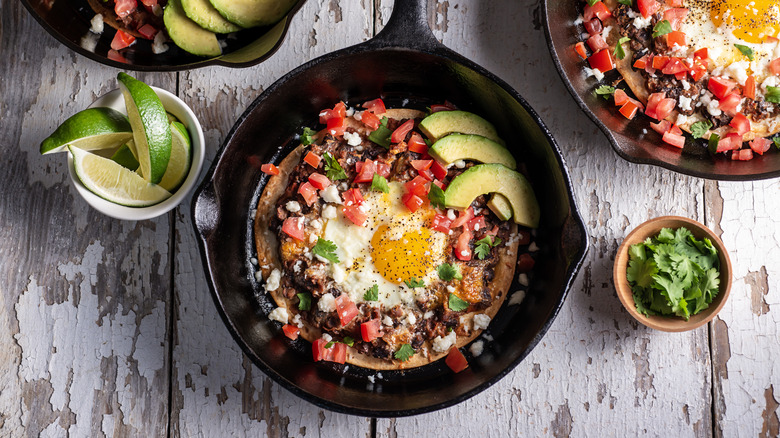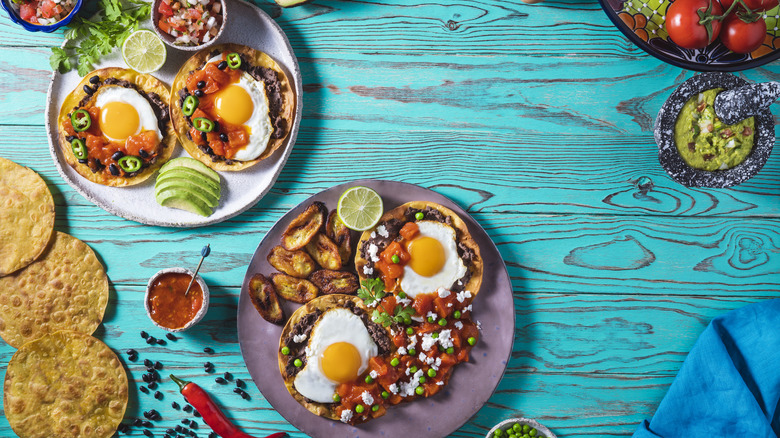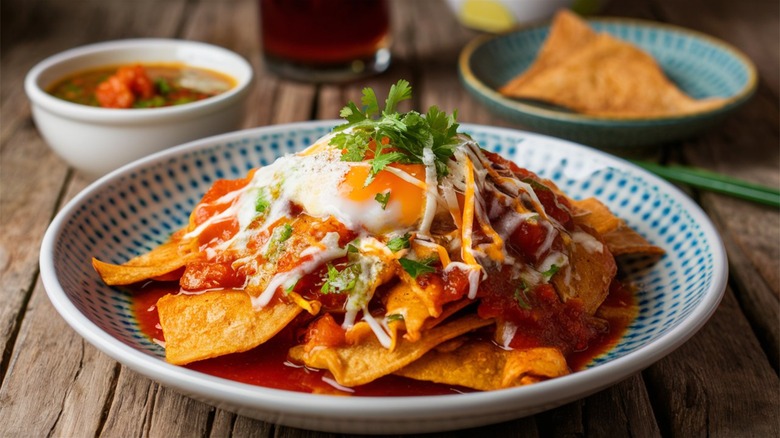Chilaquiles Vs Huevos Rancheros: What's The Difference?
Mexico is home to a host of incredible breakfast dishes. Desayuno (breakfast) menus offer sweet conchas, savory tetelas, and hearty meals of eggs, beans, and meat. Two of the most popular options are huevos rancheros and chilaquiles. While both dishes are primarily (though not only) eaten in the morning and usually include eggs, salsa, and tortillas, that's where the similarities end. The distinctions between the two aren't simply a matter of differing ingredients and preparations, though.
As with many traditional dishes, they represent differing components of Mexican and Latin American heritage. Huevos rancheros is thought to have originated as a farm worker's meal in Mexico by the 16th century, though its precise origins seem to be lost to history. Chilaquiles, meanwhile, has roots dating back to the Aztec empire while also reflecting the culinary influences of Spanish colonization.
In addition to being delicious for breakfast or brunch, both work well as hangover meals, much like ultimate breakfast burritos. Outside of traditional Mexican restaurants, you'll likely find huevos rancheros on menus at trendy brunch spots. Meanwhile, chilaquiles is sometimes served as a substitution for nachos and as an option at both casual and upscale restaurants around the world, from California to Turkey.
Huevos rancheros focuses on the eggs
Born of Mexico's agricultural tradition, hence its translated name "rancher's eggs," huevos rancheros likely formalized on farms in Northern Mexico as a second, bigger breakfast. When exactly it first appeared on restaurant menus in the United States is uncertain, but it was available at a San Antonio diner by the 1940s. The 1906 cookbook "One Hundred and One Mexican Dishes" does not include the dish.
Huevos rancheros is generally a vegetarian dish, though it sometimes may be prepared with lard. At its core, it consists of a tortilla topped with one or two eggs, usually fried sunny side up or poached, and smothered in red salsa. Common accompaniments include beans, avocado, rice, and even hash browns.
The dish is very versatile and customizable. Corn tortillas are preferred, but it's not a sin to go with flour (though they'll get soggier in the sauce). You can replace sunny-side-up eggs with scrambled (technically huevos a la Mexicana), but you lose the joy of the soft yolk running across the tortilla. In more traditional Mexican restaurants, the salsa is a very saucy tomato-based version with onion and chili peppers. But you'll often find the dish covered in chunky salsa fresca, which is great, too. Cover one egg with red salsa and the other with green, and you get huevos divorciados (divorced eggs). Though not always topped with cheese, huevos rancheros can be. The variations of this classic Mexican breakfast go on and on.
Chilaquiles is a perfect use of leftovers
Chilaquiles appears in cookbooks as early as the early 1830s, but the general consensus is that the dish we know today made it to the U.S. by 1898, per "El Cocinero Español," a cookbook by Encarnación Pinedo, which doesn't include huevos rancheros. However, the name and origins of chilaquiles date back to the Aztecs. The Nahuatl words chile (peppers) and aquile (submerged) describe a dish of dried-out tortillas served with salsa. The onions and chicken that are commonly part of the dish today were introduced to it by Spanish colonials.
Chilaquiles is built around leftovers. Unlike store-bought versions, handmade corn tortillas are made fresh daily or every couple of days. Any leftovers are put out in the sun or in an oven to dry out. For this dish, tortillas should be nice and "stale" (think croutons). Once cut into strips or triangles, they're fried and smothered in simmering salsa (either red tomato or green tomatillo-based) or mole, then topped with an egg, cheese, and often chicken.
Two elements are crucial for great chilaquiles. The tortillas must be thin enough to fry up evenly and the ratio of tortillas to sauce must be just right: a bit soupy, but not watery. After that, chilaquiles is open to interpretation. Many people swear green tomatillo sauce makes the best version, but you'll find the dish served with red and green sauces throughout Mexico. You can even ditch the egg if you don't like them for breakfast.


